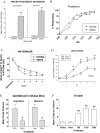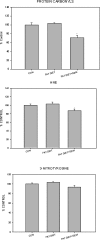Obesity and hypertriglyceridemia produce cognitive impairment
- PMID: 18276751
- PMCID: PMC2329289
- DOI: 10.1210/en.2007-1722
Obesity and hypertriglyceridemia produce cognitive impairment
Abstract
Obesity is associated with cognitive impairments. Long-term mechanisms for this association include consequences of hyperglycemia, dyslipidemia, or other factors comprising metabolic syndrome X. We found that hypertriglyceridemia, the main dyslipidemia of metabolic syndrome X, is in part responsible for the leptin resistance seen in obesity. Here we determined whether triglycerides have an immediate and direct effect on cognition. Obese mice showed impaired acquisition in three different cognitive paradigms: the active avoidance T-maze, the Morris water maze, and a food reward lever press. These impairments were not attributable to differences in foot shock sensitivity, swim speed, swimming distance, or voluntary milk consumption. Impaired cognition in obese mice was improved by selectively lowering triglycerides with gemfibrozil. Injection into the brain of the triglyceride triolein, but not of the free fatty acid palmitate, impaired acquisition in normal body weight mice. Triolein or milk (97% of fats are triglycerides), but not skim milk (no triglycerides), impaired maintenance of the N-methyl-d-aspartate component of the hippocampal long-term synaptic potential. Measures of oxidative stress in whole brain were reduced by gemfibrozil. We conclude that triglycerides mediate cognitive impairment as seen in obesity, possibly by impairing maintenance of the N-methyl-d-aspartate component of hippocampal long-term potentiation, and that lowering triglycerides can reverse the cognitive impairment and improve oxidative stress in the brain.
Figures



References
-
- Jeong SK, Nam HS, Son MH, Son EJ, Cho KH 2005 Interactive effect of obesity indexes on cognition. Dement Geriatr Cogn Disord 19:91–96 - PubMed
-
- Elias MF, Elias PK, Sullivan LM, Wolf PA, D’Agostino RB 2003 Lower cognitive function in the presence of obesity and hypertension: the Framingham heart study. Int J Obes Relat Metab Disord 27:260–268 - PubMed
-
- Sorensen TI, Sonne-Holm S, Christensen U 1983 Cognitive deficiency in obesity independent of social origin. Lancet 14:1105–1106 - PubMed
-
- Morley JE 2004 The metabolic syndrome and aging. J Gerontol Med Sci 59A:139–142 - PubMed
Publication types
MeSH terms
Substances
Grants and funding
LinkOut - more resources
Full Text Sources
Other Literature Sources
Medical

